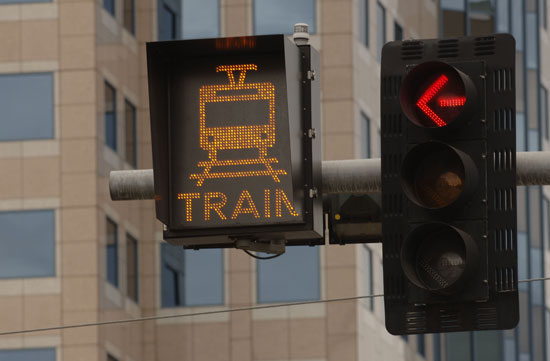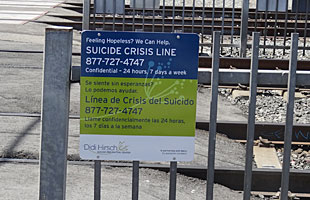Working toward a safer Blue Line
August 29, 2013

LED signs like this one in Long Beach alert pedestrians to stay off the tracks when a train is coming. Photos/Metro
One year after a task force convened to improve safety on Los Angeles Metro’s Blue Line, newly-released figures show that, while progress is being made, the line remains the deadliest in the system.
Abdul Zohbi, a system safety manager who organized the task force, says every fatality is reason for concern, but that he’s not ready to panic.
“All of our safety projects are being worked on as we speak,” Zohbi said.
Last July, officials discovered a spike in fatalities on the 22-mile light rail line from Downtown Los Angeles to Long Beach. It was on pace to experience the highest number of accidental fatalities and suicides of any year since it opened in 1990.
Acting on a motion by Supervisor Zev Yaroslavsky, Metro’s Board of Directors approved the creation of a Blue Line Task Force to find solutions for the agency’s oldest rail line.
“With our new lines, we are installing state-of-the-art devices that have come into existence in the past 20 years,” said Vijay Khawani, Metro’s executive officer of corporate safety. “A year ago we said, ‘Wait a minute, why can’t we retrofit the Blue Line?’”
Zohbi reached out to the City of Los Angeles’ Department of Transportation, the California Public Utilities Commission and Union Pacific Railroad, which runs a freight line directly alongside the Blue Line. He also invited representatives from Didi Hirsch Mental Health Services, a Culver City nonprofit organization that operates a 24-hour suicide crisis hotline.
The resulting recommendations were approved by the Board last December, and included $7.7 million for such physical improvements as pedestrian gates, bright LED signs and audible warning bell devices, although it has taken time for the measures to work their way through the bureacracy. Additional training is underway for light rail vehicle operators, including 2 days walking the line to experience the environment as pedestrians. And educational outreach to communities, another major part of the new safety program, has begun as well. “We expect the public to do their part in heeding the signs,” Zohbi said.
The outreach and training have already begun, and most of the physical improvements like the new LED signage are expected to be finished by around June of next year. But the improvements Zohbi believes will be most effective—108 new pedestrian gates—must be contracted out competitively, which will take longer.
In the meantime, safety issues continue to plague the Blue Line. According to statistics released Monday, it experienced more accidents and fatalities than all other Metro lines combined since the beginning of 2012, accounting for 56 of 77 accidents involving trains and pedestrians or cars during the period, along with 12 of 14 total fatalities.
“We need a physical barrier to stop people trying to cross the tracks illegally,” Zohbi said. “The No. 1 cause of accidental fatalities on the Blue Line is pedestrians running to catch a train. When you’re trying to save 30 seconds, you could lose your life.”
Tragically, even more deaths are intentional—half of the fatalities in 2012 and 75 percent of deaths so far this year were suicides. The task force called for suicide prevention signs with Didi Hirsch’s 24-hour hotline number to be installed at stations and other key locations. Those signs are 90 percent installed along the Blue Line. When that job is finished, they’ll be installed on the rest of the rail system.
Lyn Morris, who represented Didi Hirsch on the task force, said the signs represent “a big step ahead” by Metro.
“It wasn’t always popular to put the word ‘suicide’ on signs,” Morris said. “People like to talk around it, but when you are talking to someone who is suicidal you need to address it directly.”
The signs have only been in place for a couple of months, but Morris said her agency has already fielded calls generated by them, including some from people in a state of crisis. But beside that point-of-contact intervention, she said the signs serve a much broader purpose—spreading the word to communities across the county that someone is out there to listen and help at the most seemingly-hopeless times.
Both Morris and Bruce Shelburne, Metro’s rail operations chief, admitted that it’s next to impossible to eliminate all accidents resulting from people who break the law or attempt suicide.
“We are eating an elephant one bite at a time,” Shelburne said. “It’s a fine line—the safest train is one that doesn’t run at all.”
The Blue Line faces unique challenges. For one, it is Metro’s oldest rail line; the Teenage Mutant Ninja Turtles were used to promote its June, 1990, opening. And it runs through a densely populated part of town, with 103 at-grade crossings with other streets. Over the first 12 years of the line’s operation, it experienced more fatalities than any other line in the nation. In 1999, after a particularly rough year, Metro added safety measures that cut deaths by nearly half during the next decade.
While behavior of pedestrians and vehicular traffic can’t be predicted to a certainty, Zohbi called all fatalities “unnecessary.”
“To bring the fatalities down to zero,” he said, “that is our optimal goal.”
Posted 8/29/13













 405 bridge work causes a stink
405 bridge work causes a stink

